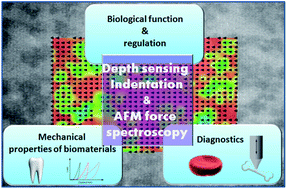The micro- and nanomechanical properties of biomaterials are of central importance as surface elasticity, surface elastic response and adhesion play a central role in a large number of biological processes. They influence, e.g. morphogenesis, self-healing abilities and restoration processes, focal adhesion, motility, mechano-transduction, metastasis and are important for drug delivery applications, and others. These processes address fundamental questions in biology, medicine and diagnostics, pharmaceutical research, archaeology, dental as well as cosmetic applications. With nanoindentation as well as AFM force spectroscopic techniques suitable investigation tools are at hand, which can provide mechanical information on different length scales. The development of both techniques resulted in a broad applicability and the number of examples where both techniques have been used to study (soft) biomaterials rapidly increased during the last years.
You have access to this article
 Please wait while we load your content...
Something went wrong. Try again?
Please wait while we load your content...
Something went wrong. Try again?


 Please wait while we load your content...
Please wait while we load your content...